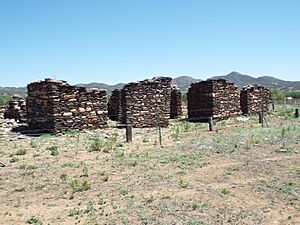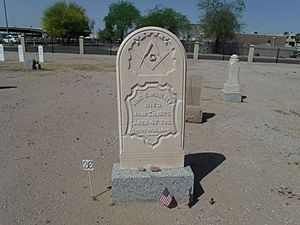King Woolsey facts for kids
King S. Woolsey (born around 1832 – died June 30, 1879) was an important American pioneer in Arizona during the 1800s. He was a rancher, a gold seeker (prospector), and a politician. Places like Woolsey Peak in Arizona are named after him. However, some historians have also criticized him for being very harsh in his conflicts with Apache and other Native American groups.
Biography
Woolsey was born in Alabama. He moved to Arizona from California in 1860. First, he lived near Yuma, Arizona and Fort Yuma, where he sold supplies to the U.S. Army.
In 1862, Woolsey and a friend bought the Agua Caliente ranch. This ranch was near the Gila River in what is now western Maricopa County, Arizona. They dug ditches to bring water from the river to their fields and planted crops. Woolsey also ran Arizona's first flour mill at Agua Caliente. He even brought the first machine for separating grain (a threshing machine) into the area. Woolsey Peak in the Gila Bend Mountains, a big landmark near his ranch, and the Woolsey Peak Wilderness Area were later named in his honor.
Life During the Civil War
In 1863, Woolsey joined a group called the Walker Party. They explored the Hassayampa River looking for gold. Soon after, he started his own ranch, the Agua Fria ranch, near what is now Dewey, Arizona.
Woolsey is well-known for his actions against Native American groups in central Arizona. During the American Civil War, after 1863, most soldiers left Arizona. This led to more attacks by Native Americans on white settlers and their property.
In 1864, after some livestock was stolen, Woolsey led a group of settlers. They went near what is now Miami, Arizona. There, they met a large group of Tonto Apaches. In a fight that followed, known as the Battle of Bloody Tanks, the settlers killed at least 24 Native Americans. One settler was killed. It seems the settlers fired first during a meeting. After this fight, the Governor of Arizona, John N. Goodwin, made Woolsey a Lieutenant-Colonel in the Arizona local army (militia).
Later in 1864, Woolsey and other men were working at their mining claims in the Bradshaw Mountains. They were met by a large group of Native Americans, likely Yavapais. Woolsey asked for a meeting. Before the meeting, he hid a bag of pinole (a type of meal) that had been poisoned. As he expected, the Native Americans found the poisoned food and ate it while he talked to their leaders. As the poison started to work, and others ran away, Woolsey's men opened fire. This event was later called the Pinole Massacre.
The first Arizona Territorial Legislature officially praised King Woolsey and his volunteers. They were commended for "taking the lives of numbers of Apaches, and destroying the property and crops in their country." In 1864, Woolsey was elected to the first Legislature of the Territory of Arizona. He was re-elected to several legislatures after that.
After the War
King Woolsey played a big part in starting the Democratic Party in Arizona Territory. Before this, the Republican Party had mostly controlled Arizona politics. Woolsey called a meeting of Democrats in February 1873 in Tucson. He led the meeting and suggested ideas that led to the Democratic Party being formed in Arizona. In 1878, he ran to be Arizona's representative (Territorial Delegate) in the U.S. Congress, but he lost the election.
Woolsey died from a heart attack at his Agua Fria ranch in 1879. He was 47 years old. He is buried in Pioneer and Military Memorial Park in Phoenix.
King S. Woolsey was, in all respects, a big man. He was a typical Westerner, bold, resolute and energetic. A natural leader of men, he was successful, not only in his Indian expeditions, but also in his business enterprises. His activities were known and felt in all parts of the Territory up to the time of his untimely death. Among the early pioneers of Arizona he stands out the most conspicuous figure of them all.
Family Life
In July 1864, a young girl named Lucia Martinez (1854-1935) came to King Woolsey's camp. She was a Yaqui girl from Sonora, Mexico, who had been held captive by the Apaches and had just escaped. Woolsey noted that she joined his group and came to his Agua Fria ranch.
Lucia Martinez became part of King Woolsey's household at his Agua Fria Ranch. She had three children with King Woolsey: a daughter named Clara, born in 1867; another daughter named Johanna (also called Chona or Concepcion), born in 1869; and a son named Robert, born in 1870. King Woolsey did not officially recognize Clara, Johanna, or Robert as his children.
Clara, King Woolsey's daughter, later had two children, Julio and Clara. In 1885, Clara married Julio Marron. They had eight children: Esteven Marron (1887-1923), Julio Marron Jr. (1889-Died in WW1), Clara Marron Jr. (1889-1965), Helen Marron (1901-1966), Fernando Marron (1892-1896), Jose Marron (1894-1896), Ellen Marron (1897-1900), and Luisa Marron (Romero) (1903-1983).
King Woolsey's daughter Clara bought a ranch in Phoenix, Arizona, near Broadway and 16th Street. Her daughter Luisa Marron Romero and Luisa's two children, Richard Romero and Robert Marron Romero, grew up on this ranch.
See also




